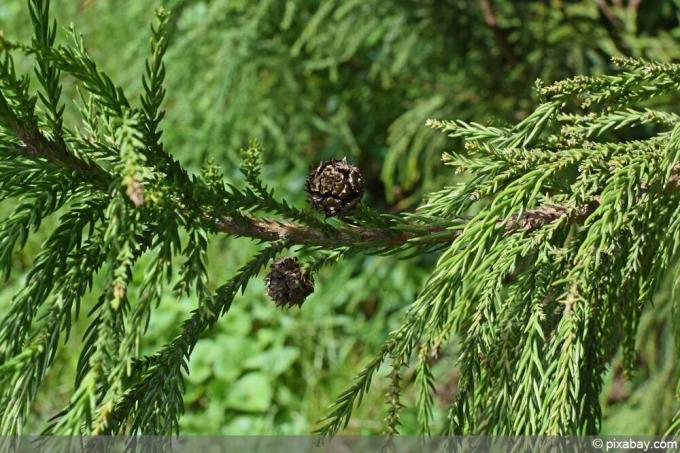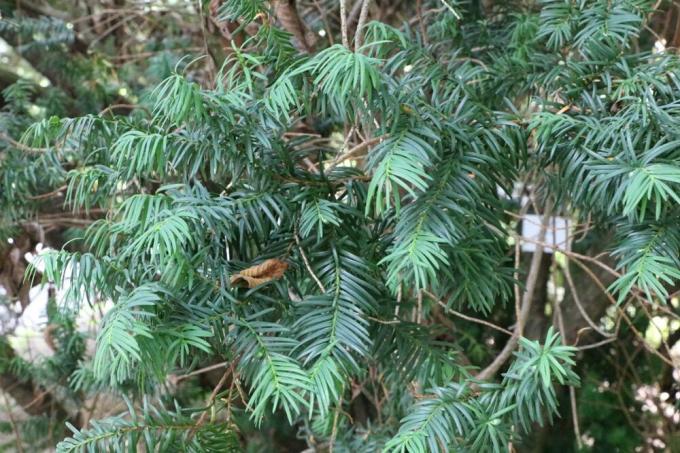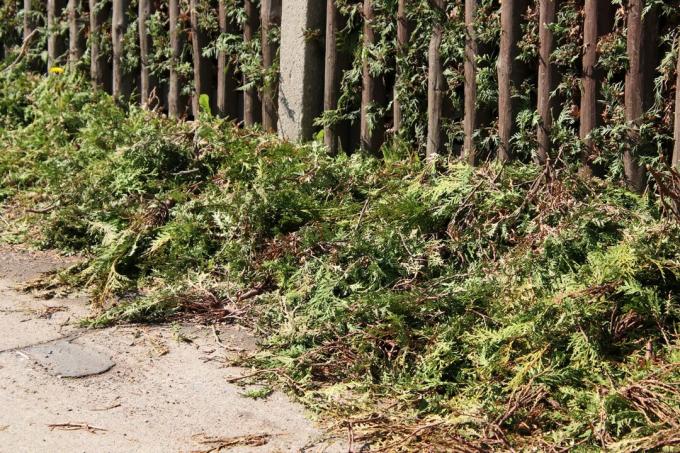

Table of contents
- conifers
- hedge plants
- Leyland cypress (Cuprocyparis leylandii)
- False cypress (Chamaecyparis)
- Tree of Life (Thuja)
- Juniper (Juniperus)
- Spruces (Picea)
- Yew (taxus)
- solitary trees
- dwarf forms
- Conclusion
The order of conifers, botanically Coniferales, includes all families of conifers. From the primeval sequoia to the spruce, from the thuja to the fir. They are all so-called nudibranchs and have evergreen needles. This makes them very attractive not only for a hedge planting. Hedges with Thuja or Leylandii plants are so popular that the term conifer is often used synonymously for this type of hedge. Below is a look at the variety of forms and the different growth behavior of the most important conifer families.
conifers
The conifers can be divided into softwoods that bear cones, such as fir, pine, spruce, and trees that bear berries, such as cypress, thuja and yew. The most popular types for an opaque hedge definitely come from the berry-bearing group.
Botanically, the order of the conifers is divided into seven plant families. For our gardens in Central Europe, mainly representatives of these three families play a role:
- Yew family (Taxaceae)
- Pine family (Pinaceae)
- Cypress family (Cupressaceae)
A further subdivision of the conifers is based on their growth height:
- Small trees: height up to 10 meters
- Medium-sized trees: between 10 and 20 meters
- Large trees: higher than 20 meters
How high the tree or hedge ultimately becomes depends on the location, care and pruning. In most cases, growth heights of over 10 meters will hardly come into question for our gardens. Especially slow-growing species such as creeping juniper and other dwarf forms are perfect for bedding or for cultivation in planters.
hedge plants
The most popular hedges are by far the genera and species of the cypress family. Here it is mainly the fast-growing, hardy species. For example, the false cypress (Chamaecyparis), the bastard cypress (Leylandii) and the tree of life (Thuja). A look at the growth habit, height, and growth rate of some popular hedging plants of the conifer order.
Leyland cypress (Cuprocyparis leylandii)

Under optimal conditions and without pruning, the Leylandii can grow to over 20 meters in height. They grow particularly fast. Therefore, with the appropriate pruning of the Leyland cypress, you quickly get an opaque and stately hedge.
- Annual growth: 50 cm to 1 m
- Height depending on location: 8 to 25 m
- Width: up to 4.50 m
Popular varieties of Leyland cypress for hedge planting:
- Green Leyland Cypress (Green Tree Cypress, Giant Cypress): very rapid growth
- Yellow bastard cypress (Cup. Leylandii Gold Rider): very fast growth
False cypress (Chamaecyparis)
There is a wide range of species among the false cypresses. Some of these tend to bare from below, so Chamaecyparis hedges are usually cut narrower towards the top so that enough light gets to the foliage below.
- Annual growth: approx. 30 cm
- Height depending on species and location: 8 to 25 m
Popular varieties of false cypresses for hedge planting:
- Blue Cone Cypress 'Ellwoodii' (Chamaecyparis law. 'Ellwoodii'): feathery, blue-green needles
- Blue cypress (Chamaecyparis law. 'Columnaris Glauca'): blue-green; slim growth
- Yellow cypress (Chamaecyparis law.'Ivonne'): bright yellow; slim growth
- Steel blue cypress (Chamaecyparis law. 'Alumii'): blue-grey to steel blue; slow growing
Tree of Life (Thuja)

Thujas are also popular for planting hedges. They don't grow quite as fast as the Leylandii, but are particularly dense. They grow narrow and mostly columnar or slightly conical. In just four to five years you can grow a stately hedge of up to two meters from young plants.
- Annual growth: up to 40 cm
- Height: 10 to 30 m
- Width: 3 to 5 m
Popular thuja varieties for hedge planting:
- Thuja Brabant (Thuja occ.'Brabant'): quite fast-growing; pretty tough
- Thuja Smaragd (Thuja occ.'Smaragd'): slow-growing; grows densely and evenly
- Thuja Martin (Thuja plicata 'Martin'): very fast-growing; bright green to dark green; loose growth
Juniper (Juniperus)
The relatively fast-growing juniper not only forms a dense, high hedge. It can even offer protection against intruders with its sharp needles. However, juniper needs a sunny location. Some columnar varieties are particularly well-suited for hedging.
- Annual growth: 15 cm
- Height: 4 to 6 m
- Width: up to 3 m
Popular juniper varieties for hedge planting:
- Chinese juniper (Juniperus chinensis 'Obelisk'): for unshaped and shaped hedges; long sharp needles
- Common juniper (Juniperus communis 'Hibernica'): dense growth; pointed, blue-green needles
- Rocky Mountain Juniper (Juniperus scopulorum 'Skyrocket'): Fast growing for tall hedges
Spruces (Picea)
Dense, very high property boundaries can also be set with spruce. They are at their best when they are not trimmed and their natural shape is shown to advantage. When planting, you should decide whether the border should grow densely or openly.
- Annual growth: up to 50 cm
- Height: over 50 m
- Width: up to 6 m
Popular varieties of spruce for hedge planting:
- Norway spruce (Picea abies): good for topiary; dense and fast growing
- Serbian spruce (Picea omorica): for natural, unshaped hedges, slender and compact
- Norway spruce (Picea pungens): for a dense hedge, trim the tips regularly
Yew (taxus)

Species of the European yew (Taxus baccata) or hybrids of the Japanese and European yew are mostly cultivated for solitary plantings and hedges. The yews are extremely easy to cut and result in a dense, elegant hedge. It grows relatively quickly when young and slows down with age.
- Annual growth: approx. 20 cm
- Height: 10 m
- Width: 10m
Popular varieties of yew for hedge planting:
- Fastigiata yew (Taxus baccata 'Fastigiata'): for narrow hedges; slow-growing, up to 2 m high
- Cup yew (Taxus media 'Hicksii'): for high free-growing and trimmed hedges
- Dwarf yew (Taxus cuspidata 'Nana'): for low hedges; extremely slow growing
solitary trees
Many of the conifers used for hedges are also ideal for solitary planting. Here the natural growth form and the ultimately expected height play a decisive role. Below are a few more suggestions for solitary plantings.
Medium-sized evergreen trees that can reach 20 meters in height
- Blue Spruce (Picea pungens 'Koster')
- Mane spruce (Picea breweriana)
- Bristlecone Pine (Pinus aristata)
Tall evergreen conifers over 20 meters tall
- Douglas fir (Pseudotsuga menziesii)
- Norway spruce or red fir (Picea abies)
- Giant sequoia (Sequoiadendron giganteum)
- Scots or red pine (Pinus sylvestris)
- Silver Fir (Abies alba)
- Atlas cedar (Cedrus atlantica 'Glauca')
Tip:
In addition to the families mentioned here, there are some exotic conifer families. As a hedge, they are rather unsuitable in our climate. As a solitary tree, however, z. B. a Chilean araucaria become a real eye-catcher. The older she gets, the better she survives the German winter.
dwarf forms
The slow-growing dwarf forms are best suited for small front gardens, for graves, as ground cover or for container cultures. Many of these cultivated forms only manage an annual increase of five centimeters. They reach a height of around 50 cm, some up to a meter.
Some well-known and charming varieties of the dwarf conifers are:
- Shell cypress (Chamaecyparis obtusa 'Nana Gracilis')
- Dwarf balsam fir (Abies balsamea 'Piccolo')
- Silver Fir (Abies procera 'Blue Witch')
- Dwarf mountain pine (pinus mugo 'Carstens Wintergold')
- Dwarf Pine (Pinus leucodermis 'Compact Gem')
- Sugar Loaf Spruce (Picea conica 'Sanders Blue')
Conclusion
Among the conifers there is a large selection of easy-care species and varieties that can grow into a dense, stately hedge relatively quickly. In addition to the ubiquitous thujas and cypresses, you can also find what you are looking for among the yew and spruce varieties. The faster the conifers grow, the better they can be cut into shape and the denser they become. If you have a little more patience and don't have to rely on a screen so quickly, you will find particularly attractive varieties among the slow-growing coniferous plants. For a hedge, it is best to opt for evergreen and hardy conifer varieties.
 Home editorial office
Home editorial office
Learn more about hedges

Rocket juniper, Juniperus scopulorum: care tips
The rocket juniper (Juniperus scopulorum) is also known as columnar juniper and can reach impressive heights. Here we show how it can be cultivated successfully. There are also some care tips that can strengthen growth and the plant.

Conifers turn brown | reasons and solutions
Conifers are used in the garden as a hedge, group or solitary. Smaller specimens of the conifers decorate the balcony or terrace in the tub. If they turn brown, you should investigate the cause, because this behavior is usually not normal.

24 easy-care hedges – privacy without work
Hedges protect more or less well from prying eyes and are a good alternative to conventional fences. However, it is not always easy to find the right plants, especially when you want them to be as easy to care for as possible.

Pruning conifers: when is the best time?
Pruning conifers is easily possible with the right knowledge. But when is the best time for the measure and when is cutting allowed? Here is the most important information about cutting the coniferous hedge.

Fertilize thuja hedges: 7 effective fertilizers
Because of its dense growth, the Thuja is particularly valued as a hedge. In order for the growth to actually take place densely and without gaps, the plant needs sufficient nutrients. We explain how you should fertilize the tree of life for lush growth.

How fast do yews grow? | Yew hedge growth
The yew (bot. Taxus) is not without reason a popular garden and hedge plant, because it is an evergreen plant and can be easily cut into different shapes. Their growth depends on location and care.


